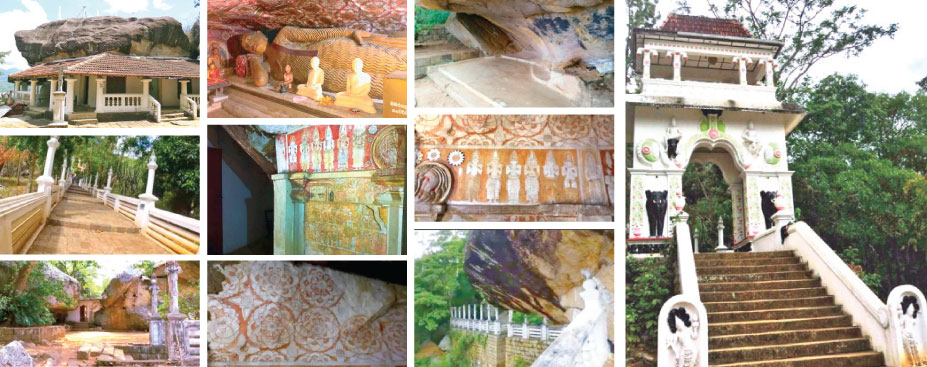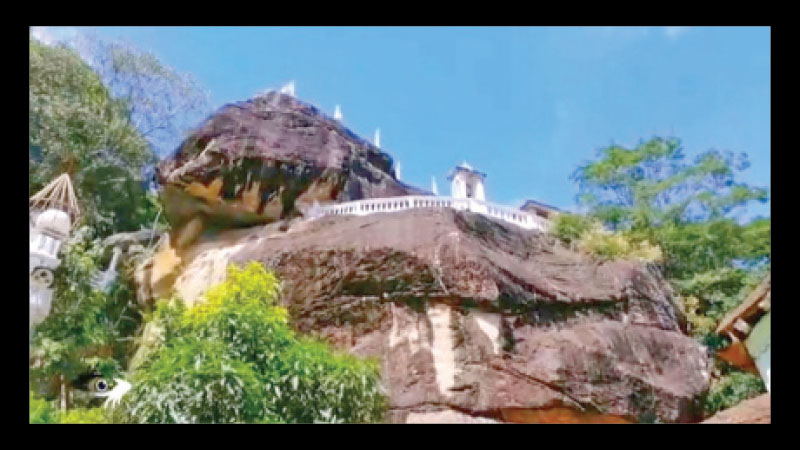Surrounded by boulders, spectacular rock formations, drip ledged caves, verdant thickets and jungles and remnants of an era long gone, an ancient Buddhist place of worship which is of paramount importance especially in terms of the historical value of the surroundings dating as far back as the pre-historic era lies majestically in a picturesque hilly landscape about 22 kilometres away from Kandy.
This temple is none other than the Bambaragala Rajamaha Vihara which overlooks the Victoria reservoir and the Knuckles range in the Dumbara Valley in central Sri Lanka. What a panoramic view of the verdant valley below and around!
When you arrive at the small scenic Digana town on the Mahiyangana- Colombo road and travel four kilometres along the Wevagama Road, you will find the road to the temple on the left. After travelling about two kilometres from there, one can reach the Bambaragala Rajamaha Vihara.
At the entrance to the temple premises is a decorated arched structure (Vahalkada) which is eye-catching with its modern floral designs and sculpture and shows a mixture of Kandyan and later architecture. This modern Vahalkada itself is an impressive work of art adding beauty, grandeur and awe to the surroundings. From there, going up a number of steps, halfway up the stairs one can see the present Buddhist priests’ residence or clergy houses on the lower terrace.
Mini art gallery
Climbing up an exceptionally steep flight of more steps, one can enter the summit of the rock temple, the upper terrace where the awe-inspiring main cave temple is located. This drip-ledged cave temple is presumably a mini art gallery which houses several Buddhist masterpieces and paintings belonging to the Kandyan era. Also, several Brahmi characters thought to have been engraved on the rocks in the 2nd and 3rd Century BC can be seen.
In addition to this main cave temple, there exist many ancient rock cave hermitages here and there in the surrounding rocky mountains. From the cave temple is a foot path leading to the top of the Pettigala mountain from where the green valley with the azure world above can be seen.
According to existing chronicles, King Kirthi Sri Rajasinghe who brought about a Buddhist religious revival in the hill capital, renovated the place and built the complete cave temple during his reign(1747-1782AD).The name of the temple ‘Bambaragala’ came into being since a plethora of wasp hives were found in the non-wet areas of the rocks in and around the temple premises.
Reclining Buddha
Inside the main cave temple whose entrance is an arched dragon pantheon is a reclining Buddha statue. The cave canopy is embellished with lotus motifs, Buddha figures, narilatha flowers, scroll patterns and bird figures. God figures are painted above the figures of the dragon. The outer wall on both sides of the Makara Thorana (Arched dragon pantheon) also has paintings. Jathaka stories such as Sasa Jathaka, and Wessantara Jathaka have also been drawn on the walls. The Bambaragala Vihara also belongs to the category of temples such as Degaldoruwa, Medawala and Suriyagoda where wall paintings depicting the Kandy tradition could be seen.
The caves said to be scattered around had been occupied by saffron robbed hermits as far back as 2000 years ago when this used to be a monastery. One of the special caves is known as the Indrasala Guhava. A Brahmi inscription dating back to two millennia has been discovered there and reads ‘Idashala Guha Saghasha’ which means the Indrasala Cave – given to monks. There is yet another inscription that reads that one cave was donated to the bhikkhus by ‘Dattaa’, the wife of the Pocini (pracheena) Raja (king).
Another large cave known as ‘Sithuvam Lena’, the cave with paintings, has ancient murals of floral patterns on its roof. There are two other caves containing Brahmi inscriptions too.
This ancient Buddhist temple complex which can be presumably thought of as a hidden gem in the green, misty mountains is a vast field of marvellous rock formations, ancient ruins and tangible work of art divulging the glory of a proud Buddhist era.










